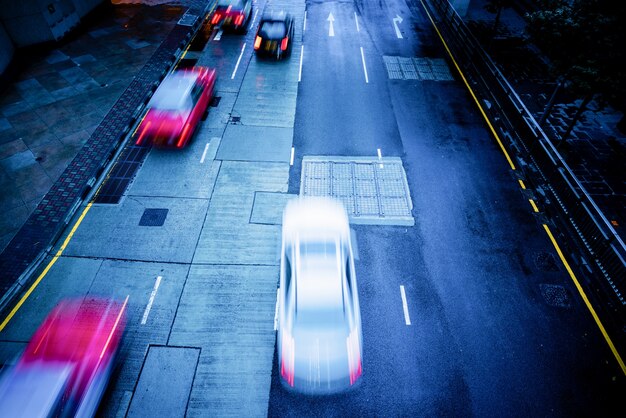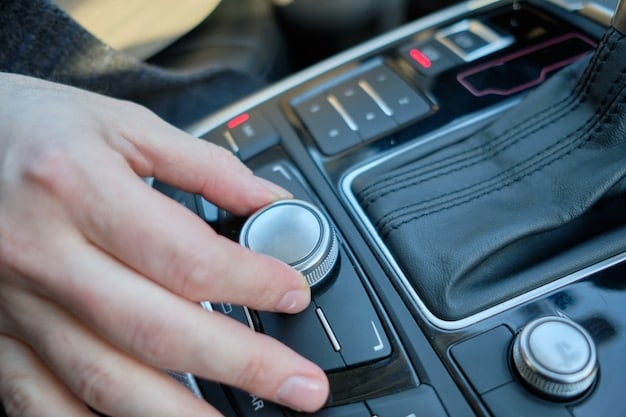The Ethics of Autonomous Driving: Navigating Liability in Accidents

The Ethics of Autonomous Driving: Who Is Responsible in Case of an Accident? explores the complex challenges of assigning liability when self-driving cars cause accidents, examining the roles of manufacturers, software developers, and vehicle owners in ensuring safety and accountability.
The advent of self-driving cars promises a revolution in transportation, but it also introduces a thorny question: The Ethics of Autonomous Driving: Who Is Responsible in Case of an Accident? As these vehicles become more prevalent, determining liability in the event of a crash becomes increasingly complex.
Understanding the Levels of Autonomous Driving
To grapple with the complexities of liability, it’s essential to first understand the different levels of automation present in vehicles today. These levels, defined by the Society of Automotive Engineers (SAE), range from no automation to full automation.
Each level presents distinct ethical and legal challenges, particularly when it comes to assigning blame in accident scenarios. As vehicles progress toward higher levels of autonomy, the locus of control shifts from the driver to the vehicle’s systems, blurring the lines of responsibility.
SAE Levels of Automation
The SAE’s levels of automation provide a structured framework for understanding the capabilities and limitations of different autonomous driving technologies.
- Level 0: No Automation: The driver is in complete control of all vehicle functions.
- Level 1: Driver Assistance: The vehicle provides some assistance, such as adaptive cruise control or lane keeping assist, but the driver must remain engaged and ready to take control.
- Level 2: Partial Automation: The vehicle can perform some driving tasks, such as steering and acceleration, but the driver must still monitor the environment and be prepared to intervene.
- Level 3: Conditional Automation: The vehicle can perform all driving tasks under certain conditions, but the driver must be ready to take control when prompted.
- Level 4: High Automation: The vehicle can perform all driving tasks under most conditions, even if the driver does not respond to a request to intervene.
- Level 5: Full Automation: The vehicle can perform all driving tasks under all conditions, and no driver is required.
Understanding these levels is crucial for determining liability, as the level of driver involvement directly impacts who is responsible in case of an accident.
In conclusion, grasping the SAE levels of automation is essential to navigating the complex ethical landscape of autonomous vehicles. It not only clarifies the capabilities of each level but also underscores their inherent limitations, setting the stage for addressing liability questions in accident investigations.
The Manufacturer’s Role in Ensuring Safety
Manufacturers of autonomous vehicles bear a significant responsibility for ensuring the safety of their products. This responsibility extends beyond simply meeting regulatory requirements.
It encompasses rigorous testing, robust design, and ongoing monitoring of vehicle performance to identify and address potential safety issues.

Testing and Validation
Thorough testing and validation are paramount to ensuring the safety of autonomous vehicles. This includes both simulated testing and real-world testing under a variety of conditions.
- Simulated Testing: Allows manufacturers to test their vehicles in a wide range of scenarios, including extreme weather conditions and unexpected events, without risking real-world accidents.
- Real-World Testing: Provides valuable data on how the vehicle performs in actual driving conditions, including interactions with other vehicles, pedestrians, and cyclists.
- Edge Case Testing: Focuses on identifying and addressing rare but potentially dangerous situations that the vehicle may encounter.
By conducting comprehensive testing, manufacturers can identify and mitigate potential safety risks before their vehicles are deployed on public roads.
To summarize, manufacturer liability is deeply intertwined with the complexity of autonomous vehicle technology. Prioritizing comprehensive safety testing is vital for establishing a robust legal and regulatory landscape that holds manufacturers responsible for the safety and reliability of their autonomous systems.
The Software Developer’s Liability
Software developers play a crucial role in autonomous driving, as they are responsible for creating the algorithms and systems that control the vehicle’s behavior. This means they also have a unique responsibility when it comes to safety.
If a software glitch or error causes an accident, the software developer may be held liable. This is especially true if the error was foreseeable and could have been prevented through better design or testing.
Algorithmic Bias and Unintended Consequences
One of the challenges facing software developers is the potential for algorithmic bias to lead to unintended consequences. Algorithmic bias occurs when the data used to train the autonomous system reflects existing societal biases.
This can result in the vehicle making decisions that disproportionately harm certain groups of people. For example, if the system is trained primarily on data from urban environments, it may not perform as well in rural areas.

In conclusion, as algorithms become more integrated into vehicle systems, recognizing and addressing potential biases is key to ensuring fairness and preventing unintended harm.
The Role of the Vehicle Owner
Even as vehicles become more autonomous, the vehicle owner still retains some responsibility for safety. This includes ensuring that the vehicle is properly maintained, that the software is up to date, and that they are familiar with the vehicle’s capabilities and limitations.
In some cases, the owner may also be held liable for accidents caused by the vehicle, particularly if they have modified the vehicle in a way that compromises its safety.
Maintenance and Updates
Proper maintenance and regular software updates are essential for ensuring the continued safe operation of autonomous vehicles. Owners must follow the manufacturer’s recommended maintenance schedule and promptly install any software updates that are released.
- Regular Inspections: Ensure that all critical systems, such as brakes, tires, and sensors, are in good working order.
- Software Updates: Install the latest software updates to address known bugs and security vulnerabilities.
- Adherence to Guidelines: Follow the manufacturer’s guidelines for using the vehicle’s autonomous features.
Neglecting maintenance or failing to install updates can increase the risk of accidents and potentially expose the owner to liability.
In summary, vehicle owners play a critical role in maintaining the safety and reliability of autonomous systems. By adhering to maintenance schedules and staying informed, owners contribute to safer roads and reduce the potential risks associated with autonomous technology.
Navigating the Legal Landscape
The legal landscape surrounding autonomous driving is still evolving, and there are many unanswered questions about liability in the event of an accident. Traditional legal frameworks, which typically assign liability to the driver, may not be adequate.
Courts and lawmakers are grappling with how to apply existing laws to this new technology, and new laws and regulations may be needed to address the unique challenges posed by autonomous vehicles.
Product Liability vs. Negligence
One of the key legal questions is whether accidents caused by autonomous vehicles should be treated as product liability cases or negligence cases. This distinction can have significant implications for who is held liable and what type of damages can be recovered.
- Product Liability: Focuses on defects in the design or manufacturing of the vehicle. If the accident was caused by a defect, the manufacturer may be held liable.
- Negligence: Focuses on whether the driver or other party acted carelessly or failed to take reasonable precautions to prevent the accident.
In some cases, both product liability and negligence claims may be brought against multiple parties, further complicating the legal process.
In conclusion, as legal paradigms evolve, drawing clear boundaries between product liability and negligence is crucial for shaping future regulations and legal strategies concerning autonomous driving.
The Future of Autonomous Driving Ethics and Liability
As autonomous driving technology continues to advance, it is essential to address the ethical and legal challenges that it presents. This requires a multi-faceted approach involving manufacturers, software developers, lawmakers, and the public.
By working together, these stakeholders can create a framework that promotes safety, innovation, and accountability in the age of autonomous vehicles.
The Importance of Transparency and Explainability
Transparency and explainability are crucial for building public trust in autonomous driving technology. The public needs to understand how these vehicles make decisions and why they behave the way they do.
Manufacturers and software developers should strive to make their autonomous systems as transparent and explainable as possible, so that people can understand how they work and feel confident in their safety.
To summarize, as technology advances, emphasizing transparency and prioritizing explainability is key to ensuring that autonomous vehicles are not only trustworthy but also aligned with public values.
| Key Point | Brief Description |
|---|---|
| 🚗 Levels of Automation | Understanding SAE levels helps define liability. |
| 🛡️ Manufacturer’s Role | Manufacturers must ensure rigorous testing and safety. |
| 💻 Software Liability | Developers are responsible for algorithmic accuracy. |
| ⚖️ Legal Framework | Evolving laws must address autonomous vehicle incidents. |
Frequently Asked Questions
▼
Responsibility can fall on manufacturers, software developers, or owners, depending on the accident’s cause. It often requires detailed investigation to determine liability in these complex scenarios.
▼
Insurance coverage in self-driving car accidents depends on whether the vehicle was at fault due to a defect or malfunction, impacting claim responsibilities and legal proceedings.
▼
Current laws are adapting; many jurisdictions are updating regulations to address specific challenges and gaps related to autonomous technologies, focusing on legal clarity.
▼
Yes, manufacturers can be held liable for defects in software that lead to accidents, making thorough testing and validation critical to mitigating potential issues.
▼
Ethical programming includes prioritizing safety, ensuring fairness, and addressing algorithm biases to minimize harm and make responsible decisions in unavoidable accident scenarios.
Conclusion
The ethics of autonomous driving and the question of who is responsible in case of an accident are complex and evolving issues. As self-driving cars become more prevalent, it is crucial to establish clear legal and ethical frameworks to ensure safety and accountability.





